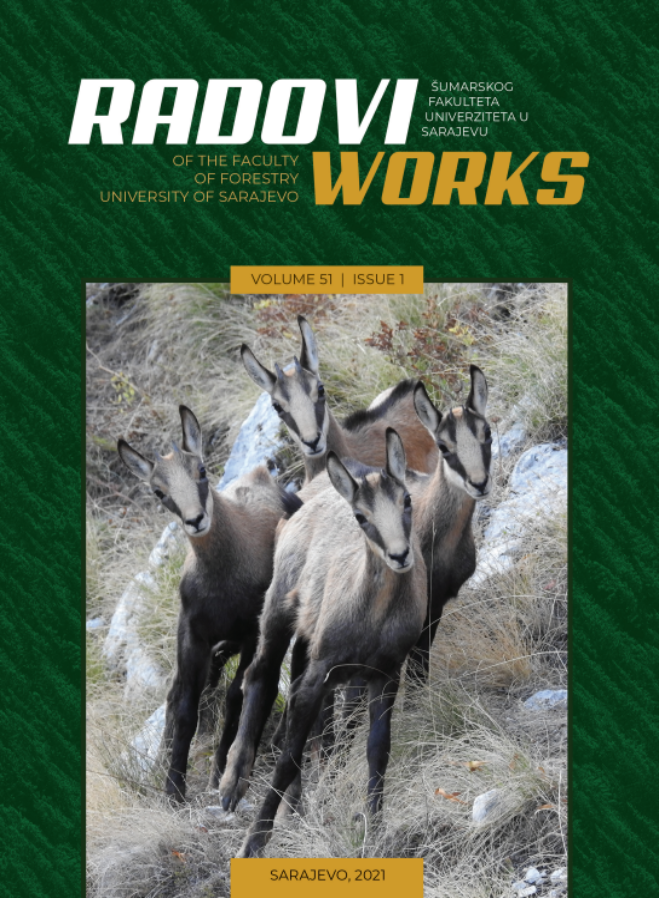Habitats and seasonal migration of Chamois (Rupicapra rupicapra balcanica, Bolkay 1925) in Special hunting ground „Zelengora“ and „Sutjeska“ National Park
DOI:
https://doi.org/10.54652/rsf.2021.v51.i1.349Keywords:
stanište, divokoza, Zelengora, NP Sutjeska, migracijaAbstract
The Balkan chamois (Rupicapra r. Balcanica, Bolkay 1925) inhabits certain mountainous areas and certain canyons of the rivers of Bosnia and Herzegovina, including the Zelengora Special Hunting Ground and the Sutjeska National Park. It is very modest in terms of nutrition, but it is demanding in terms of habitat, where peace in the habitat is considered one of the main factors for its survival and loyalty to the habitat.
The Zelengora Special Hunting Area is an example of a quality chamois habitat that provides favorable conditions at different altitudes, which it skillfully uses during daily and especially seasonal migrations, which are especially pronounced during the winter due to deep snow cover in most of the study area. The main aims of this work are: To determine the most important chamois habitats and main seasonal migration routes.
The analysis of chamois habitats and migrations in the mentioned area included the existing archival documentation, as well as constant field monitoring during the period of three consecutive years (2017-2020). During the work, we used methods according to Kunovac (2009), and we also used the drone "DJI Phantom 4 Pro V2.0". Based on the registered positions and movements of chamois during this period, we also created appropriate maps of chamois migrations on the basis of Google Earth.
We identified 11 main chamois habitat localities within Zelengora Special Hunting ground:
1.Zelengora, 2. Dumoš, 3. Bare, 4. Husad, 5. Radomišlja, 6. Treskavac, 7. Sutjeska river canyon, 8. Massifs of Maglić and Volujak, 9. Sniježnica with Perućica primary forest, 10. Vučevo and 11. Sjeračke stijene.
These areas inhabited by chamois in the Special Hunting Ground "Zelengora" are characterized by appropriate terrain configuration factors, exposure, geological background, pedological soil properties, altitudes, and associated climate that have determined certain vegetation for a suitable environment for chamois.
The total habitat area for chamois in the Special Hunting Ground "Zelengora" is 20,000 ha, while the quality of the habitat is assessed as "medium good" (Rapaić et al 2008).
Due to very harsh conditions, chamois, during the winter period, are forced to make seasonal migrations to more favorable parts of the habitat, to easily overcome the most difficult period of the year. Daily migrations are of varying intensity and depend on many factors, the most important being the availability of food, water, shelter, weather conditions, and peace in the hunting ground. Due to very specific terrains, the amplitude of vertical and horizontal migrations is very pronounced, so the amplitude of the vertical often exceeds a thousand meters above sea level. Depending on the locality, it is evident that in some areas, which provide ideal conditions throughout the year (eg Dumoš), chamois very rarely or almost never leave these locations, while on the other hand some localities (Volujak, Bregoč, Todora, etc.) they have to leave with the arrival of the most difficult winter days when the depth of the snow cover in these localities exceeds one meter, and very often much more. All this indicates the importance of pronounced and possible vertical and horizontal directions of chamois movement, due to the realization of more favorable habitat conditions in certain circumstances. One of the most notable examples is the chamois population that inhabits the area of Gornje Bare and Planinica, when due to deep snows they completely leave these harsh areas and descend to the lowest parts of Jabučke rocks and Sutjeska canyon with a very pronounced vertical line. As a rule, during snowstorms and blizzards, they descend to the very coast of Sutjeska next to the main road M20 which connects Foča and Trebinje.
References
Bačkor, P. (2008). Migrácie kamzíkov (Rupicapra rupicapra L.) na Slovensku. (Migrations of chamois in the Slovakia). Natura Carpatica. 49. 195–204.
Bačkor, P. (2010). Altitudinal Distribution and Morphological Attributes of Chamois (Rupicapra Rupicapra Tatrica) Habitat in the Western Carpathians. Acta Zoologica Lituanica. 20. 162-167. 10.2478/v10043-010-0020-9.
Fukarek, P. (1969): Osnovne prirodne karakteristike, flora i vegetacija Nacionalnog parka „Sutjeska“. Akademija nauka i umjetnosti Bosne i Hercegovine, Sarajevo.
JPŠ „Šume RS“ Sokolac, (2020): Lovna osnova za Posebno lovište „Zelengora“ 2020-2030. Istraživačko razvojni i projektni centar, Banja Luka.
Knežević M. (1938): Divokoza. Trgovačka štamparija M. Ramljak, Sarajevo.
Krofel, M. & Luštrik, R. & Stergar, M. & Jerina, K. (2013): Habitat use of Alpine chamois (Rupicapra rupicapra) in Triglav National Park.
Kunovac, S. (2009): Uputstvo za prebrojavanje divljači, Šumarski fakultet Univerziteta u Sarajevu i Federalno ministarstvo poljoprivrede, vodoprivrede i šumarstva, Sarajevo.
Laska Fr.B. (1905): Das Waidwerk in Bosnien und der Hercegovina. Klagenfurt.
Milovac, M. (2017): Monitoring populacije divokoze (Rupicapra rupicapra L.) u Nacionalnom parku Paklenica 2017. urn:nbn:hr:151:989131 Diplomski rad, Sveučilište Josipa Jurja Strossmayera u Osijeku, Fakultet agrobiotehničkih znanosti Osijek, Zavod za Lovstvo, Ribarstvo i Pčelarstvo
Nesti, Irene & Posillico, Mario & Lovari, Sandro. (2010): Ranging behaviour and habitat selection of Alpine chamois. Ethology Ecology & Evolution. 22. 215-231. 10.1080/03949370.2010.502316.
Rapaić Ž. (2000): Lovna osnova za Posebno lovište „Zelengora“ 2000-2010. Tjentište.
Rapaić Ž., Mićević M. (2002): Uređenje lovišta. Lovački savez Republike Srpske, Bijeljina.
Rapaić Ž., Kunovac S., Soldo V. (2008): Ustanovljenje staništa divokozije divljači u BiH i prijedlog za revitalizaciju populacije. Federalno Ministarstvo poljoprivrede, vodoprivrede i šumarstva, Sarajevo.
Sekulić Ž. (2012): Divokoza (Rupicapra rupicapra balcanica) u Bosni i Hercegovini s osvrtom na uzrok njenog nestajanja. Završni rad, Veleučilište u Karlovcu.
Sekulić Ž. (2020): Godišnji plan korišćenja Posebnog lovišta „Zelengora“ za 2020/21. Tjentište.
Stefanović V., Beus V., Burlica Č., Dizdarević H., Vukorep I. (1983): Ekološko-vegetacijska rejonizacija Bosne i Hercegovine, Šumarski fakultet, Univerziteta u Sarajevu, Posebna izdanja No 17., Sarajevo.



















